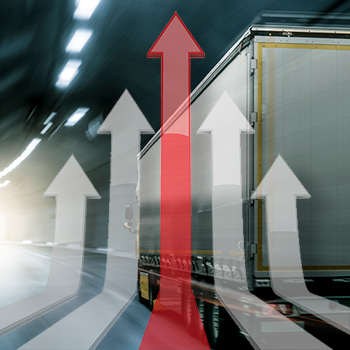Ecommerce and Outsourcing Fueling Revenue Growth for Third-Party Logistics Providers

According to the latest data from supply chain consultancy Armstrong & Associates, in 2016, the global third-party logistics market reached $802 billion and is on track to exceed $1.1 trillion in 2022.
Up, up, and away may be an appropriate way to describe the direction of the third-party logistics (3PL) market, based on data recently released by supply chain consultancy Armstrong & Associates.
This data, Evan P. Armstrong, President, Armstrong & Associates said, is basically an extension of its annual 3PL market analysis that it released over the summer.
And it is based on Armstrong’s developing of global logistics cost and 3PL revenue estimates that includes annual projections through the fiscal year 2022 and represents seven major regions and 190 countries.
“In 2016, the global third-party logistics market reached $802 billion and is on track to exceed $1.1 trillion in 2022,” Armstrong said.
“Global logistics costs were $8.2 trillion in 2016 and should surpass $11.1 trillion in 2022. Globally, the Asia Pacific region is the largest logistics market accounting for 39% of total global logistics costs and 38% of total global 3PL revenues.”
As for the years between now and the fiscal year 2022, Armstrong’s data pointed to global 3PL cost estimates for fiscal years 2018 through 2021 coming in at $894 billion, $843 billion, $951 billion, $1.014 trillion, and $1.080 trillion, respectively.
This marks a steady upward growth pattern, unlike from the fiscal year 2014 to the fiscal year 2015, which saw a 5.5% decline from $834 million to $788 million, which Armstrong said was “primarily due to the U.S. dollar strengthening against other currencies and declining fuel costs.”
Not surprisingly, the highest 3PL revenues, on a regional basis, run in tandem with the world’s most powerful economies.
For 2016, Asia Pacific 3PL revenue led the pack at $305 billion followed by North America at $199.6 billion. Rounding out the top five were Greater China at $175.3 billion, Europe at $172.3 billion, and the United States at $166.8 billion.
Looking at some of these higher revenue regions, Armstrong noted European growth is a byproduct of it coming out of economic austerity-driven recession, even though countries north of the Alps like Germany, Norway, and the Netherlands are seeing higher financial growth than their geographical counterparts.
What’s more, Armstrong observed that European 3PLs-based on 2016 regional revenue-have penetrated around 25% of the total potential market, with the outsourcing of logistics still providing for growth over and above the overall economy.
“The best Europe-based 3PLs have made acquisitions to globalize their operations and participate in developing markets with higher rates of growth,” said Armstrong.
As for North America, Armstrong said 3PLs are benefitting from an improving U.S. economy with increasing manufacturing levels, the nearshoring of some manufacturing to Mexico, and newly addressable oil and gas operations in Canada and the U.S.
“Consumers in the U.S. bounced back from the great recession of 2009 and started to spend more especially on large ticket items,” explained Armstrong. “All of these factors are driving an improved 3PL market.”
Along with continued logistics outsourcing, the ongoing impact of e-commerce on the global 3PL market cannot be understated nor overlooked, something that is made very clear in the report.
“3PL revenues from ecommerce activity are growing faster than the overall 3PL market,” said Armstrong.
“Of the $802.2 billion of total 3PL revenues globally, e-commerce related revenues are expected to grow from $40.6 billion in 2016 to $72.8 billion in 2020, making up 5.1% and 7.2% of total 3PL revenues, respectively. E-commerce 3PL business is generating a compound annual growth rate of 15.7% versus overall 3PL market growth of 6.0% for the same period.”
E-commerce 3PL revenue is seeing the greatest traction in Asia, driven by increased consumer spending and cross-border purchasing, with Asia-Pacific e-commerce customers spending $22 billion on 3PL services in 2016.
That number is expected to jump to $40.2 billion by 2020 based on a compound annual growth rate (CAGR) of 16.4%. China paces e-commerce growth in the Asia-Pacific at $17 billion, with an estimated annual CAGR of 16.3% through 2020.
The United States is also seeing the fruits of increased e-commerce activity, even with Amazon’s market share.
Armstrong said U.S. e-commerce customers spent $8.7 billion with 3PLs in 2016, with revenues pegged to increase at a 19.1% CAGR through 2020 and hit $17.6 billion by then, with e-commerce expected to account for 8.5% of the U.S. 3PL market by 2020, which is 3.3% ahead of 2016.
Related: 7 e-Commerce Enabled Warehouse Best Practices
Related Ecommerce White Papers
The Five “New Rules” of 3PL Ecommerce Fulfillment
The purpose of this white paper is to spell out “The Five New Rules of 3PL e-Commerce Fulfillment.” rules and explain how they will benefit your 3PL warehouse, it also provides the guidance you need to help your 3PL e-Commerce fulfillment business prepare for future growth. Download Now!
Transform Global Ecommerce and Maximize the Customer Experience
Global e-commerce is growing in leaps and bounds, particularly in emerging markets, where consumers can find it hard to locate affordable imported products. Download Now!
Global Ecommerce Logistics
The report contains Ti’s bespoke market size and forecasting data, as well as overviews of some of the world’s leading e-commerce businesses, such as Alibaba and Amazon. Download Now!
Precise Cross-Belt Sortation: Unlocking Efficient Ecommerce Distribution
In the burgeoning ecommerce market, speedy delivery and diverse offerings are customer expectations, and the ability to deliver these via a seamless customer experience will increasingly separate leaders from laggards. Download Now!
Five Ways to Optimize Your Distribution Center For Ecommerce Fulfillment
Today’s challenge has now become how to manage fast-moving inventory with enough precision to meet the expectations for prompt shipment of multiple small orders. Download Now!
Article Topics
Armstrong and Associates News & Resources
Armstrong report takes a look at a ‘downshifting’ in the global 3PL market Sizing up the 3PL Market with Evan Armstrong Ecommerce and Outsourcing Fueling Revenue Growth for Third-Party Logistics Providers Uber Freight Makes Official Entrance into Trucking Armstrong & Associates 2017 Top 50 U.S. and Global Third-Party Logistics Providers Keep it Running: The Quintessential Spare Parts Logistics Report Armstrong & Associates Releases “Keep it Running: The Quintessential Spare Parts Logistics Report” More Armstrong and AssociatesLatest in Transportation
Nissan Channels Tesla With Its Latest Manufacturing Process Why are Diesel Prices Climbing Back Over $4 a Gallon? Luxury Car Brands in Limbo After Chinese Company Violates Labor Laws The Three Biggest Challenges Facing Shippers and Carriers in 2024 Supply Chain Stability Index: “Tremendous Improvement” in 2023 Trucking Association CEO on New Biden Policy: ‘Entirely Unachievable’ Two Weeks After Baltimore, Another Cargo Ship Loses Power By Bridge More TransportationAbout the Author




















